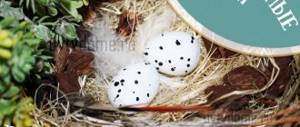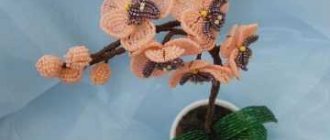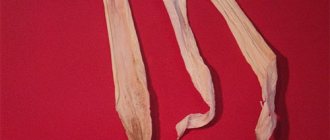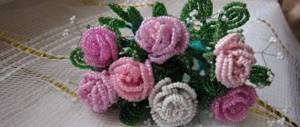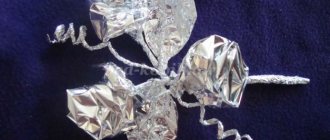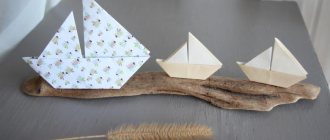You don’t have to buy beautiful, bright, juicy jewelry. You can make them yourself if you master the technique of working with polymer clay.
Polymer clay is a material whose consistency resembles plasticine. But due to heat treatment, it hardens and turns into plastic.
Polymer clay comes in many colors, shades and textures. Colors can be mixed, glitter and paint can be added to them
This material is non-toxic and even a child can work with it
You can make almost any type of jewelry from polymer clay: earrings, pendants, bracelets, watch bracelets and much more.
Fantasy is the main condition when working with this material. Flowers, fruits, animals, abstract elements - this is not a complete list of what can be realized using polymer clay
How to work with polymer clay, tips
- First, let's choose a polymer clay manufacturer. It can be expensive or cheap, with a wide range of colors, and can be sold as a set or individual bars
- Manufacturers such as Fimo, Kato, Pardo are quite expensive. There are also domestic, cheaper analogues
- Do not immediately buy packaging of different colors. Buy 1 block and try it at home: how is its texture, mixability with other plastics and paints, bake the resulting material. Good clay should not crack or change color excessively.
- For sculpting, you will need standard colors, which can later be mixed. You also need tools and a small electric oven
- Usually on the packaging of polymer clay it is written how long it needs to be baked until ready and at what temperature
- Please note that you need to work with polymer clay carefully. To maintain color purity, work with medical gloves and on a clean surface.
- If you decide to make jewelry from plastic, then in addition to clay you will need accessories: earring earrings, fastening elements, decorative details and much more.
Polymer clay
Flowers made of polymer clay: master class
- The most common and any flower is roses. At first glance it seems very difficult to do, but it’s not.
- Pay attention to the structure of this flower - many petals held together, which are larger at the outer base and smaller at the inner one
- Let's prepare the materials: we need plastic in the color of the future rose (red, pink, yellow or white), a modeling stack with a ball at the end
- Let's make preparations for future petals: pinch off a piece of clay, knead it and roll it into a ball. Large balls are for outer petals, smaller ones are for inner petals.
- Now we're missing a bud made from a thin layer of plastic
- We make each petal from a ball, using a stack we give it a curved shape (this can be done with your hands)
- We attach the petals to the bud one by one, adjusting the splendor of our flower
- The finished rose can be used for decoration. To do this, you need to cut the base and make a hole for fastening.
- Carefully place the flowers in the oven and bake until done. Then they can be opened with varnish if desired.
Roses made of polymer clay
Incredibly beautiful roses made of clay and you can make them yourself
Humanity has been trying to create artificial flowers for a very long time. People have always wanted to replicate the beauty created by nature so that it would delight them for years. One of the attempts was made by artist Carolyn Clayton, who was commissioned to decorate the windows of the world's most famous brands. She described the work process in detail. The girl used a professional kiln, but you can try to replicate her creations at home.
To create clay flowers you will need:
- Clay;
- modeling tools;
- metal sticks for the stem;
- kiln (or oven)
One of the most difficult technological processes in creating such flowers is firing them. An ideal option if you have access to a stove that can heat up to 900-1000 degrees. However, most craftsmen can only rely on an oven. In this case, you should make the flower petals thinner and burn the finished product longer. You can use special types of clay that require firing at low temperatures; they are sold in craft stores. The very principle of creating decor is universal and is suitable for home modeling.
First, prepare the clay so that the consistency is like very stiff dough, and then roll it out on the surface. It is convenient to work on linen or oilcloth.
Cut out circles for future petals. You can use not only a special form, but also a cup or jar. For one flower you will need 8-9 petals.
After that, start sculpting the petals. They should be thinner at the base than at the edges.
Form a core from the first petal by twisting it into a spiral. Bend the upper parts a little.
Attach three petals to the middle as shown in the photo. Then bend their edges and make tucks on them.
Add the remaining petals, overlapping each other.
Connect the bud and try it on the metal stem.
Cut off excess clay. After this, the buds are sent for drying.
Roses should be dried for at least 3-4 hours before firing. After this, you can put them in the oven. Firing time depends on the type of clay and maximum temperature. In a regular oven that heats up to no more than 350 degrees, you will need about 12 hours. After this, the products should be allowed to cool directly in the closed oven, and only then taken out.
And here’s how clay flowers look after painting. In the company of green leaves they seem alive.
Polymer clay earrings
Now let's learn how to turn our roses into earrings. There are two ways. One of which is simpler, the second is more difficult, but the result is simply gorgeous
Simple earrings made of polymer clay (rose blanks)
- Remove the rose blanks from the oven. They already have a hole for mounting
- To turn them into earrings we will need: a pin with a double-sided eye, rings for fastening, earrings
- We string the rose onto a pin and fasten it so that there is an eyelet at the top and bottom for attaching it to the part.
- Attach a hook to the top using a ring
- On the lower part - a bead in the color of a rose (or as your imagination dictates). The bead will make the earrings a little heavier and they will hang down without twisting.
Polymer clay earrings
Earrings in the shape of a bouquet of roses
- We need rose blanks again. But now they are raw and very small in size. They can come in a variety of contrasting colors, such as red and white
- We make a ball base. We attach roses to it using a toothpick. Make sure that they are in good contact with the base ball and do not fall off after baking
- Gaps can be filled with small green plastic leaves
- Carefully make a hole in the ball where the pin will be attached
- We bake our flower bouquet. The baking time will be slightly longer due to the greater density of the clay.
- After cooling, we attach our ball to the wire. Spectacular earrings are ready!
Earrings bouquets
Login to the site
Author: Asenka (Fairy Godmother's Box)
| Types of creativity: | Modeling – Plastic Jewelry – Plastic |
| Complexity: | below average |
| Working hours: | 2 hours |
“Vona wore kviti in her hair...” This is how one phrase conveys all the beauty and romance of the girl. “Kviti in hair”, flowers in hair..
Yes, at fashion shows, girls have luxurious bouquets the size of a tea saucer in their hair. But with my passion for microroses, today I will show you how to make a small decoration that will become an elegant accent in a summer look (Oh, I wrapped it up! In general, you can stick one hairpin in your hair and wear it every day, but if you make 5-7, it will be an addition to your evening outfit)
Today we will make a hairpin with roses. I think anyone who has ever held a plastic instrument in their hands can cope with the task. There is nothing complicated here. A little perseverance, a little stubbornness, a little perfectionism... And then everything is easy!
I admit honestly, several attempts to film this master class have already been deleted into the wonderful “trash” folder. It seems that “in life” everything is fine, but the photographs are horror-horror. Therefore, I worry in advance about the quality of the shooting and please take into account that I shoot in “super macro” mode on a regular point-and-shoot camera, and in real life all these roses are, well, a maximum of one and a half centimeters in diameter, and all that nightmare that the camera reveals can’t be seen in real life without a good magnifying glass .
Shall we try?
We will need polymer clay - a little of different colors. I am categorically against the use of plastic “from a bar”, unless it is white, of course. Don't be lazy, even if you need a red rose - add a little brown, purple, or orange to the red color. You will see - you will get a living flower, and not a piece of plastic. When making pink, don't just mix white and red. A drop of yellow and you have an unusual creamy shade. Don't feel sorry for White at all. Do you think that this pink is the limit of perfection? Mix it half and half with white and see what an amazing color it turns out!
As for green, I’m generally silent. Are you happy with the color in the pack? Place a living leaf or a blade of grass nearby - and you’ll understand everything yourself. I won’t explain for a long time, as an example I drew a diagram showing what colors I mixed to get the green color for this MK:
Yes, in “my” green there is gray and brown, and even white... But it is alive.
So, you have plastic. It’s easier for me to work with hard ones, like “Fimo Classic” or “Artifact”; it’s easier to make thin petals. You choose any one. The only thing is to be careful with Polish ones, like “Bebika”. Sometimes she's like chewing gum in the heat. And then people say “I can’t sculpt!” However, many people sculpt. See for yourself.
There are tons of workshops on sculpting roses on the Internet. Sculpt as you please. I sculpt directly on a toothpick, usually on a bamboo one, they are thinner. This way, a through vertical hole is obtained in the flower, and the rose is less wrinkled by hands during the sculpting process. You can sculpt it the way you prefer, just then pierce the flower right through the middle.
This is how I sculpt: I wrap a tiny piece of plastic around a toothpick and get the middle of a rose:
For all subsequent petal cakes, the edge MUST be flattened as much as possible, and the side to which you will attach the petal must remain plump. Only the edge should be thin. I once saw a master class on TV where petals were cut with a round cutter for roses made of polymer clay. She swore for a long time. This can be done with self-hardening clay, as far as I understand, but not with baked clay! Come on, cut it! Then at the edge of the petal there will be a pronounced thickness, and at the base it will be brittle (and how should it be?! They made it thin!) In general, don’t be lazy, sculpt the petals by hand! And you will be happy)
This scary photo clearly demonstrates the difference in the thickness of the base and edge of the petal:
And now we take the edge of the petal with two fingers and slightly squeeze them, while bending them back:
Let's sculpt further:
And further:
Don't be scared by the scary thickness of the petals and fingerprints. The entire flower is slightly larger than a fingernail; in real life this is not noticeable.
Look how thick the rose is at the base:
Do we need it? That's right, no! Using light finger movements, we “pull” the excess plastic down the toothpick, and then cut off the excess with a blade (I use a paper knife). Look, I made a mark where I will cut:
Now we take the green color and roll 5 tiny sausages about a centimeter long, pointed at one edge:
We make sepals for our rose:
Better now, right? (Damn, how visible are fingerprints in macro photography! Never mind, let’s consider them the texture of the petal!))
There is a rose! In the same manner we sculpt 2 more, I will show them later. In the meantime, let’s go to… the bathroom! And we bring from there a secret device called “the Gillette women’s machine, which is so blue.” And take the green plastic:
Please note that no other machines are suitable, because only this one has a specific handle structure:
We wet the handle of the machine with water (it is necessary, otherwise the plastic will stick!) Take a tiny piece of plastic, about the size of a tiny bean, and press it to the handle. And the pants turn into plastic, plastic turns into....
In a wonderful leaf! I forgot to take a photo, you need to make a hole at the base of this leaf (later you will see why) and the base itself should be thick and solid. Necessarily!
Here they are, three roses and two leaves, ready for baking. This is a set for one hairpin.
Usually, however, my readiness for baking looks like this:
(And there are 5-7 pieces of such foil lumps)
But we make one hairpin. The blanks are sent to the oven for 20 minutes at 130 degrees. Then they are varnished and ready for assembly.
Two words about varnish! If someone decides “this will do for the first time” and covers roses with transparent nail polish, I’m no longer friends with him and I don’t write master classes for him! It’s a pity that the Internet doesn’t give me the opportunity to touch those beads that I covered with something from Oriflame three years ago.. No, half are normal! And half of the surface turned into a disgusting sticky greasy mess. I keep them as memories and take them to master classes to show my students what not to do. Either normal varnish or no varnish. No polish is still better than nail polish. OK?
So, the blanks. Varnished and dry.
And here are ready for assembly:
In addition to the blanks, we will need the actual hairpin, several transparent beads and thin wire, 30 centimeters long. I have nichrome, it’s very thin (but it doesn’t darken), I immediately fold the wire in half.
Retreat. I have already made several hundred hairpins, so as not to lie. And I came to the assembly sequence that I will now show. And in what order you will collect is up to you. From changing the places of terms, you know...)))
So, take a leaf, thread a wire through the hole and twist the wire about 8-10 mm (Now it’s clear why the base of the leaf should be thick? To withstand tight twisting!) Like this:
Next to it is the second leaf:
Now pay attention: we put the hairpin on top of the fork of the leaves. I can’t explain it, but I’ll show you:
Visible or not visible?
Now we make several turns of wire around the pin. I have a double wire, it seems I wound a lot, a lot. No, three turns in total. You know, I’ll tell you: it’s better to have an extra turn of wire than a decoration that’s fallen apart to hell. Here, I reeled it in:
Now we bring one end of the wire up and put a rose on it:
Next, we put a bead on the wire and pass the wire through the rose from top to bottom, pulling it tightly to the hairpin:
Attention! Very important! Be careful not to kink the wire before you have pulled it all the way back through the rose. Kinks should be generally avoided, because any, even the strongest wire, will break sooner or later if you put in effort. So you don’t need to apply them! We work gently and slowly.
In the same way we attach two more roses:
And the work is almost finished! All that remains is to secure and cut off the ends of the wire (I usually bring the ends up, between the roses, and cut them short. This way, the tip of the wire will not scratch the scalp, and it should not catch the hair)
This is what the pin looks like from the inside out:
So that this whole adventure of a composition does not crawl sideways along the hairpin at a crucial moment, we fix the hairpin upside down and drop a drop of transparent glue of the “Moment” type (I use the constant “Desmokoll”) at the place of twisting. The glue will help hold the wire, pin, and rose bases together. The only point is that the glue should not be very liquid, but should form a voluminous drop, which then slowly spreads. Well, or drip carefully and less, help yourself with a toothpick. But I definitely recommend gluing it.
That's all. All these studs are made in this simple way:
And these:
And these:
In the latter, instead of leaves there is a chip of a moonstone, but the principle is the same!
Good luck to you! I hope everything works out!
Keywords: roses, hairpin, hairpin with roses, hair decoration
Materials: polymer clay, wire, beads
Polymer clay bracelet
- First, let's figure out what elements the bracelet consists of: the base (chain, rope, wire or fishing line), clasp and decorative elements
- We purchase the base and clasp from a hardware store, but we make the decorative elements ourselves
- Let's make a bright berry bracelet from raspberries and blackberries. It will complement any summer look and looks very original.
- To make raspberries, we need pink clay and green clay for the leaves. Making berries is very simple. The base is a dense plastic ball. Small balls of a similar color are attached to it. The balls are smaller at the bottom and larger at the top. We attach leaves to the base of the berry and attach a wire. Bake the berries according to the instructions for working with clay
- We make blackberries in the same way, but from black or dark purple plastic
- To make our bracelet brighter, in addition to the berries, we will attach beads to the base
- For the base of such a bracelet, it is better to use a chain with a decorative clasp
Bright bracelet made of polymer clay
Roses made from self-hardening polymer clay
Self-hardening polymer clay is an excellent material for creating amazing flower arrangements. These flowers can be used to decorate any surface: photo frames, wedding glasses, boxes, etc. With this master class, anyone can learn how to make roses and no special knowledge is required.
There are a few tips you should listen to before you start working with this clay. Self-hardening clay quickly loses moisture. Therefore, you cannot leave the blanks on the table and go away for a while - the clay will dry out and lose its properties. But there are also advantages - flowers made from such clay, after drying, turn out to be almost weightless and durable.
There are a number of polymer clay manufacturers, but in this master class the roses will be made from FIMO Air Light self-hardening polymer clay. Perhaps you have clay from another manufacturer.
We knead the clay in our hands for about 30 seconds and shape it into a sausage shape in our palms.
We cut off the required amount using a stack or break it off with our fingers (the clay is very soft), and immediately close the package. Additionally, it is better to wrap it in film or a bag so that the clay does not dry out.
Mode: Stack the sausage into as many pieces as there are petals in the rose. It is necessary to decide in advance on the size of the rose. The size of each petal and their number depend on this.
We roll each piece into a ball using our palms and put these balls in a bag so that the clay retains its properties for as long as possible.
We form the first petal, which will be the middle of the rose. Place the ball on your palm, pressing it with your thumb. Do not form all the petals at once - after attaching one, only then take on the other.
We make a movement that allows you to “smear” the clay over your hand, forming the shape of a petal. Make sure that the petal is not thin. If it doesn’t work out right away, then remember the clay in your hands again, form a ball and repeat the movement.
Using your thumb above the petal and your index finger below the petal, smooth the surface of the petal to an even thickness. This movement will make the edge of the petal more flexible, and the fingerprints and pits from your fingers will help create a relief that imitates the surface of a rose petal.
We begin to twist the first petal. You control how much the rose will open.
After twisting the petal, we squeeze the clay at the end to secure it.
Another 1-2 petals will have smooth edges.
Next, having formed the petal, we will make sure that its edge is folded. You just need to curl the edges down a little with your fingers.
We attach the petals one by one, securing them at the very bottom. Make sure that the petals do not fall apart when fastening.
The rose is ready.
Since the rose was molded specifically for decoration, it is necessary to give its base the appropriate shape. We cut off the unnecessary clay with scissors so that the base is even. Maintain the integrity of the rose when cutting.
From the cut clay you can make another rose, only of a smaller size. The sculpting pattern is repeated.
Let the roses harden for a day and you can decorate any surface with them.
Polymer clay ring
- A polymer clay ring can be made in two ways: solid plastic or based on
- A solid ring is made using a mold. A mold is a heat-resistant silicone mold that is filled with plastic and baked with it. The hard plastic is then simply removed from the mold, sanded and varnished
- For the second version of the ring you need a base. There are many such bases in hardware stores, where there is a niche for attaching plastic
- You can imagine endless ways to decorate a ring. There are a lot of options, but the simplest and most versatile option is flowers.
- A ring paired with earrings or a necklace looks especially original.
Solid rings
Ring based
DIY clay
It is not always possible to purchase clay for modeling in a store, and even more so, the desired shade may not always be available. Therefore, there are ways to create plastic surgery at home. To do this, you will need 5-6 drops of baby oil and one teaspoon each of flour, cornstarch and all-purpose white glue. Oil is added to the ingredients mixed to the consistency of clay to eliminate excess stickiness. Acrylic paint can be given the desired shade by dropping it onto a piece of plastic mass and mixing it in your hand.
Polymer clay beads
- To learn how to make beads from polymer clay, first learn how to make smooth, neat beads
- Even ordinary beads are not so easy to make so that they are the same size and correct shape. Practice making even balls of the same size and making holes in them for fastenings
- Once the basics are mastered, you can begin making decorative beads
Polymer clay beads with metal effect
- Such beads are difficult to distinguish from metal ones. But thanks to your imagination they will be unique
- We will need gray or metallic plastic, an embossing element (for example, a button) and tools
- First, roll out a smooth ball of plastic
- Now we roll out the plastic into a dense layer and use a button to emboss it. To prevent the button from sticking to the polymer clay, moisten it with water.
- Then carefully cut out the embossed elements with a blade and attach them to the ball
- We decorate the joint with a decorative plastic cord
- Make a hole in the bead for fastening
- These beads can be used for beads, bracelets, earrings and much more.
Polymer clay beads
LiveInternetLiveInternet
Quote from Zarya's message
Read in full In your quotation book or community!
MK for assembling a necklace from Ekaterina
For assembly we will need: 1 - rosettes made of polymer clay (with 4 holes), 2 - leaves made of polymer clay, 3 - wire d=0.3 mm 2 m long, 4 - jewelry cable about 70 long cm, 5 - clasp, 6 - clamping beads, 7 and 8 - beads of two colors (in fact, there may be many more colors or none at all), 9 - pliers and wire cutters (for working with wire)
Let's get started...
1. Start assembling the necklace from the middle. We take the central rose, you can first lay it out on the table approximately where the roses will be, where the leaves will be. We put a cable into one hole and a wire into the other. Moreover, the middle of both the cable and the wire should be in the middle of the rosette. IMPORTANT: the cable must always be horizontal, it does not move or bend. The wire moves and wraps around the cable.
At both ends we twist the wire around the cable, as shown in the following figure. It is necessary to make 2-3 turns around the cable
2. Make a twig with beads. We collect 3 beads on the wire (if you have large beads, then one bead will be enough)
We bend the wire with beads into a loop like this
Use your fingers to press the loop close to the beads and twist it in any direction, but most importantly in one direction
If you have pliers, it’s easier to grab the wire with them.
We twist the wire for the twig until it reaches the cable
And again we make a couple of turns of wire around the cable.
Further, by analogy, you can make several more branches with beads (in the figure they are indicated as 1, 2 and 3).
It is worth noting that the cable is still in a horizontal position and is not bent. Only the wire bends around the cable.
3. Attach the leaf. A leaf and one bead are placed on the wire. The beads are pressed with your fingers so that they cover the hole on the leaf. Next, the wire is twisted in the same way as on branches with beads. After this, the wire is also secured with a couple of turns around the cable.
After the leaf, you can also add a twig with beads. Thus, we collected the first report in our necklace.
From the reverse side the report looks like this:
4. Next, by analogy, we collect the second report.
(aka from the inside out):
... and then as many reports as you have planned (wrong side):
5. Now you need to hide the remaining tail from the wire. Carefully bring the wire back to the last rose and pass it back through the hole:
Now we pass the wire through the hole perpendicular to the cable
after each time, the wire must be tightened more tightly, then we thread the remaining tail into the hole into which the wire was pulled for the first time (photo 1 in paragraph 5)
we tighten the wire again and bite off the remaining tail with pliers close to the rose, this must be done carefully so that this edge does not scratch the skin later
6. This is what half of our necklace looks like
Next, by analogy, we assemble the remaining part of the necklace:
and the finished necklace from the inside out:
7. Now you need to make a clasp for the necklace. To do this, measure the required length of the necklace (you can simply bend the cables in the right place), but do not cut anything off yet
On the free end of the cable we put 2 clamp beads, beads (optional), again 2 clamp beads and half a clasp
Next, we thread the free tail through the clamping beads and beads again so that the clasp remains in the loop
Using pliers we clamp the beads (without beads) and squeeze well, move the beads and clamp the last beads, cut the cable very close to the last clamping bead so that it does not scratch the skin later
By analogy, we assemble the second half of the fastener
8. By analogy, you can put together earrings like these to go with a necklace
Master Class
Series of messages “Jewelry made from polymer clay”:
Part 1 — Master class “Beads with butterfly wings” made of polymer clay Part 2 — Lesson — ASTRA earrings Part 3 — Accessories for jewelry. Let's meet, learn, know! Part 4—MK on assembling a necklace from Ekaterina Part 5—How to make plastic beads with your own hands. Master class Part 6 - Pendants and beads made of plastic and epoxy... Part 26 - Orchid earrings made of polymer clay Part 27 - Small microns from Mila Ignatik. Polymer clay. Part 28 - Master class by Marina Volkova. Blueberry and butterfly made of polymer clay.
Polymer clay necklace
- Making a massive summer necklace from polymer clay is more difficult and requires some skill.
- For it we need: plastic, decorative beads, chain and fastening
- First, draw a sketch and decide where which elements will be placed
- Then we will prepare individual flowers, leaves and beads
- For the base, we need a piece of thinly rolled plastic of the desired shape. Choose only high-quality plastic for such work, otherwise a poor base simply will not withstand the abundance of elements and will break
- After preparation, we attach all the elements to the base according to the sketch. Don't forget to make holes for attaching to the chain
Polymer clay necklace
Hair decorations made of polymer clay
- Polymer clay can be used to decorate hair clips, headbands and garters.
- You can attach the elements to the base using special glue or invisible fishing line
- For any products consisting of several elements, you need to make a sketch, because imagination does not always correspond to the result
Delicate flowers for decorating hairpins and headbands
- We will need: polymer clay and stacks (you can use a toothpick)
- Knead a piece of clay of the desired color and roll it into an oval
- We make cuts, the same number as the number of petals planned
- Now we make each petal, bending it using a stack
- We give the flower the desired shape, trim off the excess plastic
- The middle can be decorated with yellow plastic stamens or simply filled with paint
- These flowers can be used for all types of decorations. They are very reminiscent of apple or apricot flowers
Flowers for polymer clay jewelry
Ceramic floristry
This direction of applied art is becoming increasingly popular; clay products are in good demand. Plastic roses can be used in different ways: in flower arrangements or handmade decorations, but in any case they will look beautiful. Moreover, there are no two identical flowers made of clay. They may be very similar in appearance, but not a single craftswoman can achieve absolute identity. Yes, there is no need for this - after all, handmade flowers created from plastic, as well as bouquets made from them, delight connoisseurs of this type of art.
Clay flowers are used to effectively decorate various interior objects:
- vases;
- panel;
- wall clock;
- furniture and other items.
In addition to interior objects, plastic roses can be used to decorate gift wrapping, women's jewelry and accessories, jewelry boxes, and even wedding bouquets. By the way, the design of wedding events is now quite a popular area, so the profession of a ceramic floristry master has become popular.
However, different types of clay are used for different purposes. Thus, clay, which requires firing, is used in the manufacture of beads, hairpins and headbands, handbags and brooches. And the one that has the ability to harden on its own is used to create flower arrangements where the petals have a given shape.
Modeling with children
Sculpting with clay is not only interesting, but also useful, because this activity can be one of the great ways to spend time together with children. Moreover, their age is not so important - even a very small child can knead and roll out clay. And even little fidgets will enjoy squeezing plastic out of the extruder. They will watch, as if enchanted, how the parts they create turn into a beautiful flower. It is worth noting that compositions made from such flowers “live” for quite a long time and can be perfectly preserved for many years.
So, we have already found out that even a beginner can try to make flowers from plastic without much difficulty. Master classes for beginners are easiest to find on the Internet; there are also video lessons and step-by-step training. One viewing is enough to create the simplest flower.
Learning to sculpt
In the process of sculpting, you will need not only hands, desire and material, but also a comfortable workplace, as well as tools . Let's look at them in a little more detail:
Clay headbands
- For clay rims, it is better to choose a thin base, plastic or metal.
- When securing the elements, make sure that they do not cling to the hair.
- Here are examples of headbands for inspiration:
Clay headband
Clay headband
Clay headband
Hairpins made of polymer clay
- The basis of the hairpin can be an old plastic hairpin, a regular automatic hairpin or bobby pins
- To ensure that the hairpin lasts a long time, do not choose elements that are too massive for small bases.
Hairpin ideas:
Hairpins made of polymer clay
Hairpins made of polymer clay
Brooch made of polymer clay
- Let's make a simple but cute cat brooch from polymer clay
- We choose a cat template that we like. We print it on the printer in the required size and cut it out
- Now we prepare the plastic, rolling it into a thin layer
- Place the template on the plastic and carefully cut out the desired shape with a blade.
- Then we decorate our brooch at our discretion. This can be done using small elements, sparkles, strands and much more. Don't limit your imagination
- We bake our brooch and use glue to attach it to the base.
Brooch idea
Cat template
Cats template
Polymer clay pendants
- Making an original abstract pendant is easier than it seems
- To do this, we will need plastic of several colors and a special machine for rolling out plastic.
- This machine allows you to roll out polymer clay evenly and, what is important, create a smooth color transition
- This result can be achieved without a machine, but it is painstaking work.
- We lay the plastic in the desired color scheme and roll it into a thin layer
- Then we cut off even thin strips and roll them into circles
- It looks original if the edges of the strips are rough
- Bake the resulting element. It can be used as a pendant or part of a necklace
Plastic pendant
